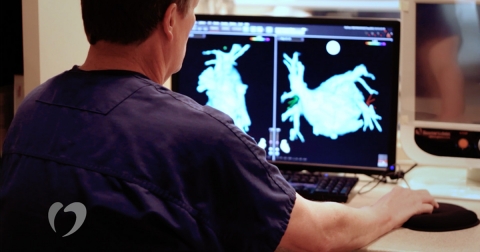Catheter Ablation: What Patients Need to Know

A catheter ablation is a procedure used to treat a variety of heart arrhythmias, including atrial flutter, atrial fibrillation, premature ventricular contractions, ventricular tachycardia and more. For some life-threatening arrhythmias, ablation is scheduled as soon as possible after diagnosis. For other less severe arrhythmias, medication may be recommended first and ablation second.
For most patients, the catheter ablation procedure typically takes between two and four hours. The electrophysiologist will use quick needle sticks to place catheters in blood vessels in the groin. The doctor then uses x-ray to guide the long, thin tubes through the blood vessels to the heart. Once there, the catheter can detect electrical signals directly from the heart muscle and identify the exact location of abnormal tissue to be destroyed. Then the doctor can use either heat or freezing techniques to destroy the abnormal tissue.
In most cases, your electrophysiologist will know before the procedure whether heat or freezing techniques are best to treat your specific arrhythmia. However, new information can be found once the catheters are in place, thus it’s important to seek a doctor who has a full range of tools available during the procedure. Physicians at the Oklahoma Heart Hospital can utilize either procedure at any time during a catheter ablation to ensure the best outcome for each patient.
As with any medical procedure, there are risks to be considered. The biggest risks during catheter ablation are bleeding, infection, puncture of the heart or lung, or damage to the heart valves or heart muscle. Your Oklahoma Heart Hospital physician will discuss these risks with you and answer any questions you may have prior to the procedure.
Recovery times for ablations can vary for each patient but are relatively short for most. Some patients are discharged to go home the same day, whereas others may stay overnight in the hospital for monitoring. Most patients are up and walking the same day of the procedure, and then simply need to avoid heavy exertion or exercise for about a week. After the ablation, there’s generally one follow-up appointment with the electrophysiologist, and then the patient returns to the care of his/her primary care physician or cardiologist.
Unlike medications for heart arrhythmias, which a patient must continue to take to manage the arrhythmia, a successful catheter ablation results in the patient being cured. For most arrhythmias, catheter ablations have a 95 percent success rate. In patients with atrial fibrillation, the amount of abnormal tissue to be addressed may require a second ablation procedure.
If you are living with a heart arrhythmia that is not effectively managed with medicine or want to avoid side effects of medication use, contact the Oklahoma Heart Hospital today for more information about catheter ablation.




